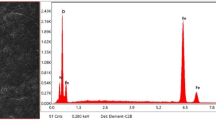Summary
-
1.
We found that the inclusions along the boundaries have different shapes in rolled 40KhNMA steel with and without ferrocerium. Probably this is one of the reasons for the difference is the impact strength of samples in the transverse direction.
-
2.
We showed that the rare earth metals do not prevent inclusions along the grain boundaries.
Similar content being viewed by others
Literature cited
A. F. Belyakova, Yu. V. Kryakovskii, and I. V. Paisov, MiTOM (1965), No. 9.
D. MacLean, Grain Boundaries in Metals [Russian translation], Moscow, Metallurgizdat (1960).
M. G. Lozinskii, Structure and Properties of Metals and Alloys at High Temperatures [in Russian], Moscow, Metallurgizdat (1963).
N. V. Keis and A. I. Komissarov, MiTOM, (1963), No. 8.
A. P. Gulyaev and E. A. Ul'yanin, MiTOM (1963), No. 8.
Author information
Authors and Affiliations
Additional information
Translated from Metallovedenie i Termicheskaya Obrabotka Metallov, No. 11. pp. 41–42, November, 1965
Rights and permissions
About this article
Cite this article
Belyakova, A.F., Paisov, I.V., Kryakovskii, Y.V. et al. Reasons for the high impact strength of steel containing rare earth metals. Met Sci Heat Treat 7, 755–757 (1966). https://doi.org/10.1007/BF00663637
Issue Date:
DOI: https://doi.org/10.1007/BF00663637




